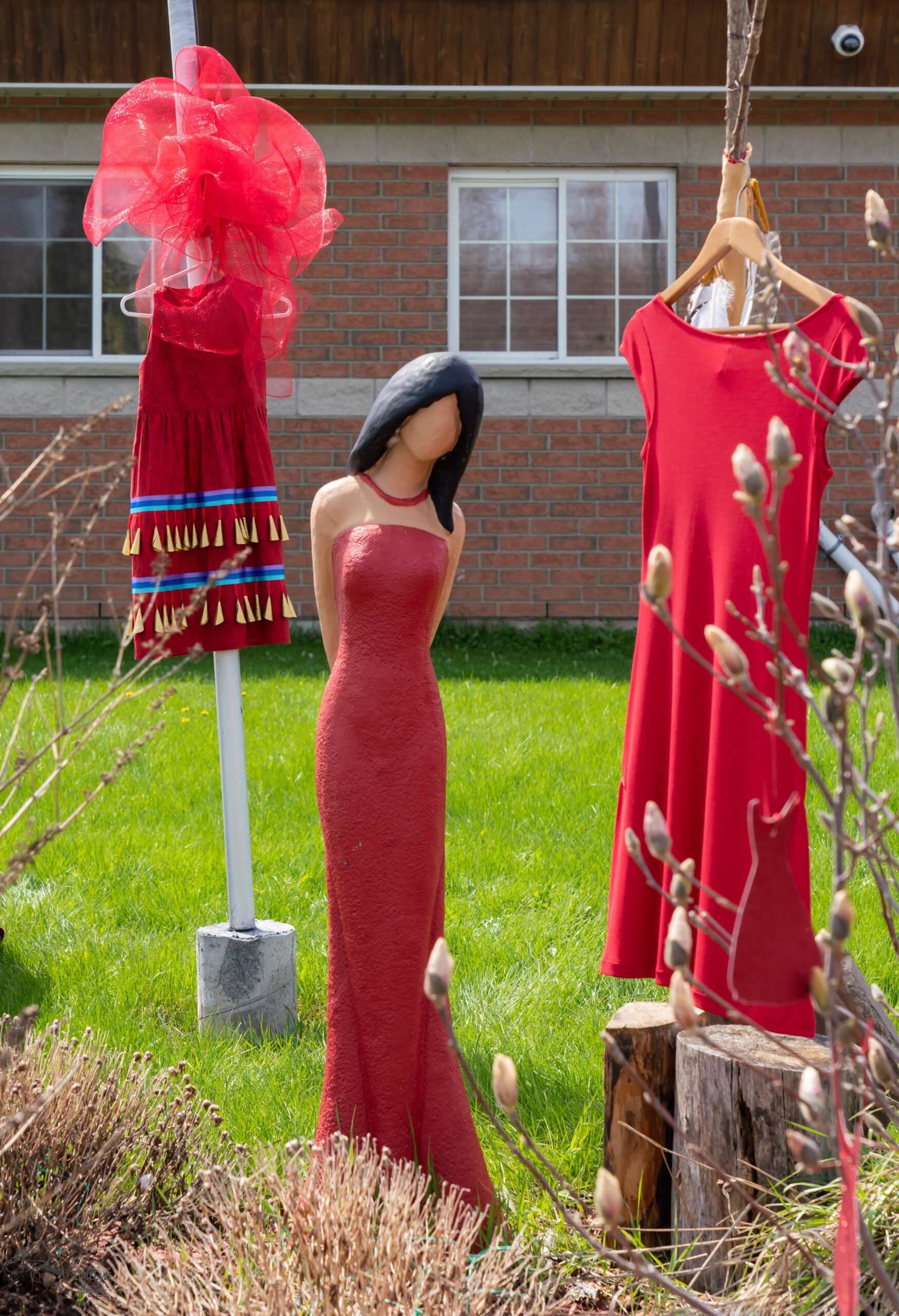SAUGEEN – The haunting cry of a Mi-Gi-Zi’ (Eagle) filled the air during a ceremony honouring murdered and missing Indigenous women, girls, and 2-spirits (MMIWG2S).
This is a significant and humbling experience to be joined by that Mi-Gi-Zi’; many Anishnaabeg people believe the Mi-Gi-Zi’ is the one who speaks to the Creator on our behalf and feel honoured when they see one.
Held on the grounds of Kabaeshiwim, the respite women’s shelter located on the Chippewas of Saugeen First Nation, about 30 people came to show their support and respect to those who never came home.

Missing posters of two young Indigenous women who disappeared in 2008, a haunting reminder to those who attended a ceremony to remember and honour MMIWG2S, at the Chippewa of Saugeen women’s shelter on May 5. (Cory Bilyea photo)
In the background, two missing posters with the faces and names of two young women connected to Saugeen, one of the missing girls is the granddaughter of respected Saugeen Elder and knowledge keeper Vernon Roote.
Shannon Mary Dale Alexander, 17 and Maisy Marie Odjick, 16, were last seen on Sept. 6, 2008 in Maniwaki, Quebec.
Although both girls disappeared without taking any of their personal items, their purses, backpacks, identification, and medications were left behind; according to reports, the police initially listed the girls as runaways and did not open a missing persons file for several weeks.
On Sept. 12, 2008, the Kitigan Zibi Anishinabeg First Nation set up a press conference to seek the public’s assistance, but unfortunately, only one local reporter showed up.
The lack of police and media response to missing Indigenous people is what several women who spoke to the small gathering of people talked about.
Cheryl George, manager of Kabaeshiwim, welcomed the people and thanked them for coming out to show their support for this critical, ongoing issue, amid a collection of red dresses.
The red dress is a symbol meant to draw attention to the missing and murdered and the lack of police response, despite the pleas from their families to find out what happened to them.
“May 5 is a day that we bring awareness for the missing and murdered women and girls, and including the men,” George said. “We have some men out there that are missing as well.”
The group began collecting red dresses during the year. They are hoping to collect more to place them all over their territory, especially on the highway that runs through it.
“That’s a travel road,” she said.
“And that’s where most of our women have gone missing,” referring to Highway 21 that runs through Saugeen territory and the Highway of Tears, the infamous highway in B.C. where many women have disappeared.
The Highway of Tears is a 725-kilometre corridor of Highway 16 between Prince George and Prince Rupert, B.C.
George talked about the rising number of MMIWG2S people who continue to disappear; the estimate is currently around 5,000 missing.
“This is just the reported cases, what about the women and girls who have not been reported,” said George.

A red dress display at the MMIWG2S ceremony held on May 5 at the Chippewa of Saugeen women’s shelter. (Cory Bilyea Photo)
National Day of Awareness for Missing and Murdered Indigenous Women, Girls, and Two-Spirit peoples, also known as Red Dress Day, is held annually on May 5.
However, the issue is ongoing. A recent announcement from the Vancouver police states they have identified the body of a young Indigenous woman discovered near an abandoned building in April as 24-year-old Chelsea Poorman, missing since September 2020.
The coroner’s report does not deem her death suspicious. Still, the fact that Poorman’s remains were left undiscovered for nearly 18 months outside of an abandoned house is very concerning.
Sheila Poorman, Chelsea’s mom, told The Tyee journalist Jen St. Denis that the police didn’t take her seriously, waiting 10 days to issue a press release.
“They just didn’t seem like they were too interested in looking for Chelsea. At one point the police officers told my one daughter that they had more important things to do,” Sheila said.
The lack of response from many police agencies, including the RCMP, is an all too familiar complaint from loved ones of missing Indigenous people; the dismissal of concerns and nearly zero communications quite often leave families alone and in the dark, and some parents passing away, never knowing what happened to their child.
Lou Thomas, knowledge keeper from Six Nations, said, “It started in B.C., not the Red Dress, but the whole idea of the unheard cries of the people, of the families, losing their loved ones.”
Thomas talked about Indigenous lawyer Beverly Jacobs, the lead researcher of “No More Stolen Sisters,” a ground-breaking report on Canada’s missing and murdered Indigenous women by Amnesty International.
“That was a really important start to this discussion,” said Thomas. “It’s really not about the red dress.”
The Truth and Reconciliation Calls to Action include a request for a public inquiry. The Indigenous Watchdog reports that “the federal government’s MMIWG Action Plan is widely panned by a majority of Indigenous women’s advocacy groups for its lack of substantive details, timelines or budget.
“Entitled Reclaiming Power and Place, the National Inquiry’s two-volume final report released on June 3, 2019 calls for transformative legal and social changes to resolve the crisis that has devastated Indigenous communities across the country. It delivers 231 individual Calls for Justice directed at governments, institutions, social service providers, industries and all Canadians in addition to the recommendations and calls for immediate action included in the Interim Report.”
The Assembly of First Nations (AFN) and the AFN Women’s Council released Breathing Life into the Calls for Justice: An Action Plan to End Violence Against First Nations Women, Girls and 2SLGBTQQIA+ People with recommendations in four priority areas:
Justice: address barriers and inequalities in Canada’s justice system.
Human security: ensure equitable access to basic needs, including shelter, food, and education.
Health and wellness: provide services and programs that are culturally appropriate and trauma informed.
Culture as safety: make cultural identity a priority in all preventative, supportive, and healing activities.
Indigenous Elder and Knowledge Keeper Peter Shuler spoke to the Wingham Advance Times about the Red Dress and the Orange Shirt symbols, sharing his thoughts on the importance of digging deeper and learning more.
“One of the things I kind of look at, the Orange Shirt and the Red Dress can become just a checkbox,” said Shuler. “If you don’t get the stories behind them, why the orange shirt and why the red dress, that can be just a checkbox for people.”
Added Shuler, “It’s like a flag or something to get your attention and then you start digging into it, digging into the stories behind that. When you see the Orange Shirt or the Red Dress, don’t stop there, don’t make it a check box. Do some research, do some digging.”
As the ceremony wrapped up in Saugeen, George reminded people to be vigilant, keep an eye on each other, try to travel in pairs, and report any suspicious incidents.
If you have any information on these or other missing person cases, you can contact the Missing Children Society of Canada at 1-800-661-6160 and the Missing Children’s Network at 1-888-692-4673.



